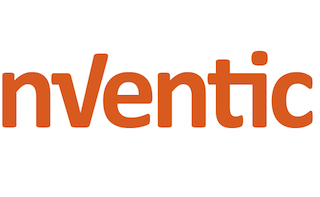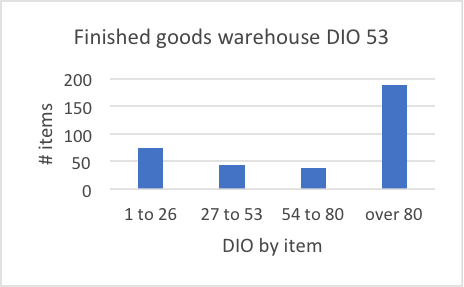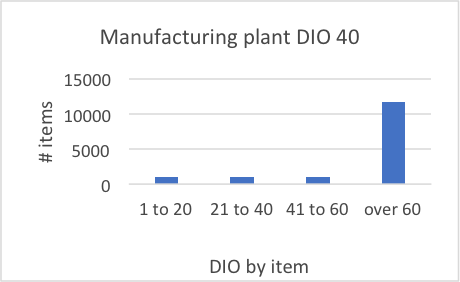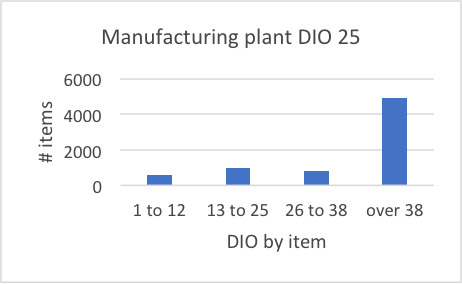
The ultimate guide to DIO
Days Inventory Outstanding (DIO) is an interesting metric. At nVentic, we often use it as a conversation starter – a first outside-in look at how a company is doing in terms of inventory management. The fewer days’ inventory you have, the quicker your cash conversion cycle will be. As such, DIO is a useful component of a balanced supply chain scorecard. But what exactly is DIO and what does it really tell you about a company’s inventory levels?
What is DIO?
Days Inventory Outstanding is the value of inventory held divided by an average day’s cost of sales.
Let’s break that down.
Company A’s balance sheet shows an inventory value of €1 billion. The income statement shows cost of sales of €3.65 billion. This means that an average day’s cost of sales is €10 million (€3.65 billion / 365 days). Which in turn means that the €1 billion inventory is equivalent to 100 days’ cost of sales (€1 billion / €10 million).
If you like formulas, DIO = Inventory value / (Annual cost of sales / 365)
DIO of 100 implies that you have inventory to cover you for 100 days’ average activity, although this is misleading and we will return to what it is really telling you (and what it’s not) below.
The big advantage of DIO is that it is a very simple metric to calculate quickly based on publicly available information. Only privately held firms that do not report their figures, and a relatively small number of firms that do not break down their costs in a way which isolates cost of sales, prevent anyone from calculating DIO for any company. For more detail, and variants on the formula, see the technical notes at the end of this article.
Let’s break that down.
Company A’s balance sheet shows an inventory value of €1 billion. The income statement shows cost of sales of €3.65 billion. This means that an average day’s cost of sales is €10 million (€3.65 billion / 365 days). Which in turn means that the €1 billion inventory is equivalent to 100 days’ cost of sales (€1 billion / €10 million).
If you like formulas, DIO = Inventory value / (Annual cost of sales / 365)
DIO of 100 implies that you have inventory to cover you for 100 days’ average activity, although this is misleading and we will return to what it is really telling you (and what it’s not) below.
The big advantage of DIO is that it is a very simple metric to calculate quickly based on publicly available information. Only privately held firms that do not report their figures, and a relatively small number of firms that do not break down their costs in a way which isolates cost of sales, prevent anyone from calculating DIO for any company. For more detail, and variants on the formula, see the technical notes at the end of this article.
What does DIO tell you?
DIO is a simple metric with which to compare companies, although this only really makes sense when comparing companies in the same or very similar industries. For instance, if you manufacture Scotch Whisky and you allow your product to mature for an average of 10 years before you sell it, there is little point in comparing your DIO with that of a business which buys and sells cut flowers.
If you compare the DIO of two companies in the same industry and with comparable products, then – all other things being equal – the one with a lower DIO is likely to be more efficient. That “all other things being equal” is an important point since differences in DIO can be driven by either structural or performance differences.
The structure of your supply chain is a major driver of DIO. If you have highly variable demand, make to stock and have very long supply lead times, you will need much more inventory than if you have stable demand, make to order and have short lead times. For instance, if your strategy is to source components from the other side of the world while your direct competitors source locally, you will need more inventory than them.
If there are no major structural differences at play, then comparing DIO between companies is indicative of efficiency, and having higher DIO than your main competitors is a strong hint that you have good potential to improve your inventory levels. Although it is also worth saying that, as very few companies are anywhere close to optimising their inventories, having a lower DIO than your competitors is not necessarily a reason for complacency.
If you compare the DIO of two companies in the same industry and with comparable products, then – all other things being equal – the one with a lower DIO is likely to be more efficient. That “all other things being equal” is an important point since differences in DIO can be driven by either structural or performance differences.
The structure of your supply chain is a major driver of DIO. If you have highly variable demand, make to stock and have very long supply lead times, you will need much more inventory than if you have stable demand, make to order and have short lead times. For instance, if your strategy is to source components from the other side of the world while your direct competitors source locally, you will need more inventory than them.
If there are no major structural differences at play, then comparing DIO between companies is indicative of efficiency, and having higher DIO than your main competitors is a strong hint that you have good potential to improve your inventory levels. Although it is also worth saying that, as very few companies are anywhere close to optimising their inventories, having a lower DIO than your competitors is not necessarily a reason for complacency.
What does DIO not tell you?
What DIO cannot do is tell you how much inventory you should have. Optimal inventory levels need to be calculated bottom up, based on the properties of each individual item that you stock. The optimal level will depend on the service level you are targeting, your lead times, the variability in your supply chain and a number of other factors.
If you can calculate your optimal inventory levels bottom up, then you could in principle turn that into a DIO target, although this is not so simple, since any change in inventory is also likely to involve a change in cost of sales. But if you are genuinely in a position where you regularly calculate how much inventory you should hold and compare it with actuals, then you have a much more operationally useful KPI than DIO in place anyway. At nVentic, we have automated the bottom-up calculation of optimum inventory levels.
DIO should not be seen as a proxy for service level. Intuition might seem to tell you that low DIO could indicate a higher risk of shortages, but there is limited data to support this view. Shortages are not caused by not having enough inventory overall, but by not having enough of the right inventory. By definition, if you have a positive DIO, you have not completely run out of inventory. Companies that manage their inventories well have lean inventories and high service levels simultaneously.
And finally, DIO does not actually tell you how much inventory cover you have. In our example, Company A had 100 days inventory outstanding. In a simplistic sense, this implies that they have enough inventory on hand to cover 100 days’ worth of sales. But, of course, they don’t, since DIO is just an average based on value. They actually have more or less than 100 days item by item – in a lot of cases much more or less.
This much probably seems obvious. There is no way you could actually hold exactly 100 days’ worth of sales in inventory unless you had completely uniform and predictable demand. But how much do you think the distribution of days’ inventory typically varies from the mean? Do you have something akin to a bell curve in mind? Let’s have a look at some actual examples of different types and sizes.
If you can calculate your optimal inventory levels bottom up, then you could in principle turn that into a DIO target, although this is not so simple, since any change in inventory is also likely to involve a change in cost of sales. But if you are genuinely in a position where you regularly calculate how much inventory you should hold and compare it with actuals, then you have a much more operationally useful KPI than DIO in place anyway. At nVentic, we have automated the bottom-up calculation of optimum inventory levels.
DIO should not be seen as a proxy for service level. Intuition might seem to tell you that low DIO could indicate a higher risk of shortages, but there is limited data to support this view. Shortages are not caused by not having enough inventory overall, but by not having enough of the right inventory. By definition, if you have a positive DIO, you have not completely run out of inventory. Companies that manage their inventories well have lean inventories and high service levels simultaneously.
And finally, DIO does not actually tell you how much inventory cover you have. In our example, Company A had 100 days inventory outstanding. In a simplistic sense, this implies that they have enough inventory on hand to cover 100 days’ worth of sales. But, of course, they don’t, since DIO is just an average based on value. They actually have more or less than 100 days item by item – in a lot of cases much more or less.
This much probably seems obvious. There is no way you could actually hold exactly 100 days’ worth of sales in inventory unless you had completely uniform and predictable demand. But how much do you think the distribution of days’ inventory typically varies from the mean? Do you have something akin to a bell curve in mind? Let’s have a look at some actual examples of different types and sizes.
As you can see from the examples, which are typical for manufacturing industries, only a small percentage of items (less than a quarter) is within the two quartiles either side of the mean. The average DIO is therefore rather a poor indicator of how big an inventory buffer you actually have.
However, this pattern is not necessarily as bad as it might at first appear.
First of all, each item that you stock will have its own optimal level that can vary greatly in terms of the average number of days it should have on hand. For items that are quick to acquire or produce and have stable and predictable demand, you might only need to keep a day or two on hand at any one time. Whereas for items with high variability and long lead times, you might need to keep much more on stock. If you are trying to keep the same amount of stock on hand for all items – and this is what happens when you use “cover” targets – then you are actually working against inventory optimization.
The other thing you will notice from the examples above is how the graphs are skewed to the right. This is because the overall DIO figure is weighted by value, whereas the graphs are simply showing the number of items. Most organisations have a long tail of “C” articles, which are low volume and low value items. It is not uncommon to have well over a year’s stock for such C items, simply because minimum order quantities (MOQ’s) are greater than a year’s demand. This is hard to change and generally not worth the effort to try changing. If the aim is to reduce overall DIO, it is usually much better to focus on your high value/volume items.
However, this pattern is not necessarily as bad as it might at first appear.
First of all, each item that you stock will have its own optimal level that can vary greatly in terms of the average number of days it should have on hand. For items that are quick to acquire or produce and have stable and predictable demand, you might only need to keep a day or two on hand at any one time. Whereas for items with high variability and long lead times, you might need to keep much more on stock. If you are trying to keep the same amount of stock on hand for all items – and this is what happens when you use “cover” targets – then you are actually working against inventory optimization.
The other thing you will notice from the examples above is how the graphs are skewed to the right. This is because the overall DIO figure is weighted by value, whereas the graphs are simply showing the number of items. Most organisations have a long tail of “C” articles, which are low volume and low value items. It is not uncommon to have well over a year’s stock for such C items, simply because minimum order quantities (MOQ’s) are greater than a year’s demand. This is hard to change and generally not worth the effort to try changing. If the aim is to reduce overall DIO, it is usually much better to focus on your high value/volume items.
Conclusions
DIO has a number of weaknesses. It is not a very precise metric, being open to a certain amount of manipulation (see the technical notes below). And it doesn’t, despite what its name might suggest, really indicate how well buffered you are against shortages, since the actual amount of inventory held by item is likely to vary so greatly from the mean.
And yet, DIO still has a useful role to play as part of a balanced supply chain scorecard. It is a valid indicator of how efficiently your supply chain uses cash. DIO may not represent how many days’ supply you have in inventory at all accurately, but it does represent how long your cash is tied up in inventory on average. And to this extent, it is a valid financial comparator when looking at competing organisations. It is a valuable lagging indicator of your supply chain efficiency. And should act as a spur to look at your inventories much more closely bottom up.
And yet, DIO still has a useful role to play as part of a balanced supply chain scorecard. It is a valid indicator of how efficiently your supply chain uses cash. DIO may not represent how many days’ supply you have in inventory at all accurately, but it does represent how long your cash is tied up in inventory on average. And to this extent, it is a valid financial comparator when looking at competing organisations. It is a valuable lagging indicator of your supply chain efficiency. And should act as a spur to look at your inventories much more closely bottom up.
Technical notes on DIO:
You will sometimes see variations on the DIO formula we give above.
Some Finance departments calculate using 360 days in a year instead of 365.
The number of days in a year aside, the main valid alternative to the formula we use is to calculate inventory value by averaging the value of inventory on hand at the start and the end of the period in question. So, in our example above, we would sum the inventory value at the start and end of the year and divide the result by 2.
There are arguments for and against using this approach. If you have been growing very fast during the year, for instance, then your average cost of sales might be significantly below the cost of sales run rate at the end of the year and you could argue that averaging inventories is better, so that numerator and denominator are treated similarly. On the other hand, if your sales have been flat over the year but you have built up a significant amount of extra inventory, averaging inventory levels between the beginning and end of the year will understate the amount of inventory you’re holding at the end.
You will also sometimes see alternatives to the cost of goods sold being used. These alternatives typically fall into two camps:
Some Finance departments calculate using 360 days in a year instead of 365.
The number of days in a year aside, the main valid alternative to the formula we use is to calculate inventory value by averaging the value of inventory on hand at the start and the end of the period in question. So, in our example above, we would sum the inventory value at the start and end of the year and divide the result by 2.
There are arguments for and against using this approach. If you have been growing very fast during the year, for instance, then your average cost of sales might be significantly below the cost of sales run rate at the end of the year and you could argue that averaging inventories is better, so that numerator and denominator are treated similarly. On the other hand, if your sales have been flat over the year but you have built up a significant amount of extra inventory, averaging inventory levels between the beginning and end of the year will understate the amount of inventory you’re holding at the end.
You will also sometimes see alternatives to the cost of goods sold being used. These alternatives typically fall into two camps:
- Using sales instead of the cost of sales
- Using a modification of cost of sales, for instance only using the cost of materials and overheads, or excluding inventory impairment charges from the cost of sales
The first of these has the one advantage that it is quick and simple – and not all organisations report cost of sales – but strictly speaking it is a dubious approach, since inventory on the balance sheet is valued at cost (or at resale value only if the value is less than cost – which you would hope to be the case only exceptionally!) By using cost of sales, you make sure you are aligning the denominator and the numerator in your DIO calculator.
The second alternative, using a modification of cost of sales, may be done for a variety of reasons that no doubt make sense to the organisations employing it. In any case, it is fair to say that cost of sales calculations leave a fair amount to any organisation’s discretion. Generally Accepted Accounting Principles (GAAP) have relatively little to say about cost of sales. The accounting methods used (FIFO, LIFO, average cost method) will often have a material impact on the cost of sales recorded. Plus, inventory valuation and the speed of writing off obsolete inventory can be managed to influence short term figures. Controlling for all such variables is not possible. We think it is best to accept that DIO is an approximate metric and work with the simplest metrics, requiring a minimum of analysis of financial statements.
A common alternative KPI to DIO is inventory turns, or inventory turnover, which is essentially measuring the same thing, just expressed differently.
Inventory turns = cost of sales / inventory value.
Going back to our example of Company A above, the cost of sales of €3.65 billion and inventory of €1 billion indicate an inventory turn of 3.65. So DIO of 100 is expressing the same thing as an inventory turn of 3.65. Noting that those who favour inventory turns as a measure tend to prefer using the average of start and end inventory since the focus is, as the name suggests, more on the movement of the inventory – the turns – rather than the amount of inventory – the days.
The second alternative, using a modification of cost of sales, may be done for a variety of reasons that no doubt make sense to the organisations employing it. In any case, it is fair to say that cost of sales calculations leave a fair amount to any organisation’s discretion. Generally Accepted Accounting Principles (GAAP) have relatively little to say about cost of sales. The accounting methods used (FIFO, LIFO, average cost method) will often have a material impact on the cost of sales recorded. Plus, inventory valuation and the speed of writing off obsolete inventory can be managed to influence short term figures. Controlling for all such variables is not possible. We think it is best to accept that DIO is an approximate metric and work with the simplest metrics, requiring a minimum of analysis of financial statements.
A common alternative KPI to DIO is inventory turns, or inventory turnover, which is essentially measuring the same thing, just expressed differently.
Inventory turns = cost of sales / inventory value.
Going back to our example of Company A above, the cost of sales of €3.65 billion and inventory of €1 billion indicate an inventory turn of 3.65. So DIO of 100 is expressing the same thing as an inventory turn of 3.65. Noting that those who favour inventory turns as a measure tend to prefer using the average of start and end inventory since the focus is, as the name suggests, more on the movement of the inventory – the turns – rather than the amount of inventory – the days.
Would you like to receive more content like this, direct to your inbox? We publish white papers on a range of supply chain topics approximately once every one to two months. Subscribe below and we will notify you of new content. Unsubscribe at any time.
Would you like to talk to one of our experts? Contact us




